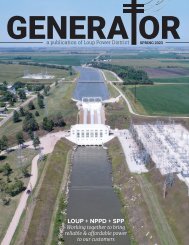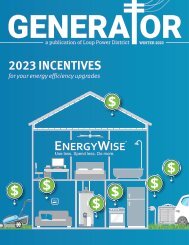Winter 2019 Generator
Learn about Schuyler's Solar Farm in this issue of the Loup Generator.
Learn about Schuyler's Solar Farm in this issue of the Loup Generator.
Create successful ePaper yourself
Turn your PDF publications into a flip-book with our unique Google optimized e-Paper software.
GENERA OR<br />
a publication of Loup Power District WINTER <strong>2019</strong><br />
SOLAR<br />
in SCHUYLER<br />
— page 8
BOARD<br />
OF DIRECTORS<br />
Larry Zach<br />
Chairman<br />
Chris Langemeier<br />
First Vice Chairman<br />
Ross Knott<br />
Second Vice Chairman<br />
Alan Drozd<br />
Secretary<br />
Dick Tooley<br />
Treasurer<br />
Rich Aerni<br />
Robert Cerv<br />
Jim Donoghue<br />
Mike Fleming<br />
Steve Heesacker<br />
EXECUTIVE STAFF<br />
Neal Suess<br />
President/ CEO<br />
Walt Williams<br />
Vice President,<br />
Administrative Services/CFO<br />
David Bell<br />
Vice President,<br />
Development/Marketing<br />
Ron Ziola<br />
Vice President, Engineering<br />
Dan Hellbusch<br />
Vice President, Operations<br />
The<br />
The<br />
difference<br />
difference<br />
a<br />
a<br />
bulb<br />
bulb<br />
makes<br />
makes<br />
Just how much difference does choosing a<br />
Just how much difference does choosing a<br />
different kind of light bulb make on how much<br />
different kind of light bulb make on how much<br />
you spend on energy? Here’s a quick<br />
you spend on energy? Here’s a quick<br />
comparison of key stats about incandescent,<br />
comparison of key stats about incandescent,<br />
compact fluorescent (CFL), and light-emitting<br />
compact fluorescent (CFL), and light-emitting<br />
diode (LED) bulbs.<br />
diode (LED) bulbs.<br />
The difference a bulb makes<br />
Just how much difference does choosing a different kind of<br />
light bulb make on how much you spend on energy? Here’s a<br />
quick comparison of key stats about incandescent, compact<br />
fluorescent (CFL), and light-emitting diode (LED) bulbs.<br />
INCANDESCENT CFL LED<br />
Brightness 800 lumens 840 lumens 840 lumens<br />
Energy used 60 watts 13 watts 9 watts<br />
Cost per bulb* $1.49 $2.49 $1.37<br />
Yearly energy $7.55 $1.64 $1.13<br />
cost**<br />
Estimated 1.8 years 11 years 13 years<br />
lifespan (2,000 hours) (12,000 hours) (15,000 hours)<br />
Total cost $83.78 $18.89 $12.67<br />
over 10 years<br />
*Prices quoted all come from the same large retailer<br />
for comparably sized and style bulbs<br />
**Assumes use of 3 hrs/day at average public power<br />
bundled rate of 11.5 cents/kwh<br />
*Prices quoted all come from the same large retailer for comparably sized and style bulbs<br />
**Assumes use of 3 hrs/day at average public power bundled rate of 11.5 cents/kwh<br />
The Loup <strong>Generator</strong> is<br />
published quarterly as a<br />
service for Loup employees,<br />
families, friends and<br />
associates.<br />
For feedback, story ideas<br />
and submissions, contact:<br />
Stacy Wemhoff<br />
Communications Coordinator<br />
402-562-5711<br />
swemhoff@loup.com<br />
Considering the average<br />
home uses about 40<br />
bulbs, the difference for<br />
one home over 10 years is<br />
more than $2,800 in cost<br />
savings, and more than<br />
22,000 kilowatt hours in<br />
energy savings.<br />
Considering the average<br />
Considering the average<br />
home uses about 40<br />
home uses about 40<br />
bulbs, the difference for<br />
bulbs, the difference for<br />
one home over 10 years is<br />
one home over 10 years is<br />
more than $2,800 in cost<br />
more than $2,800 in cost<br />
savings, and more than<br />
22,000<br />
savings,<br />
kilowatt<br />
and more<br />
hours<br />
than<br />
in<br />
22,000<br />
energy<br />
kilowatt<br />
savings.<br />
hours in<br />
energy savings.<br />
2 GENERATOR
PRESIDENT'S MESSAGE<br />
Board of Directors changes for <strong>2019</strong><br />
As a result of the election in November,<br />
the District will see a change in the Board<br />
of Directors, although not as dramatic of a<br />
change as we saw in the 2016 elections.<br />
There was also change in the local,<br />
statewide and national elections, although,<br />
similar to the elections for the District’s<br />
Board of Directors, not as much change as<br />
was seen during the 2016 election cycle.<br />
This change is what makes life<br />
fascinating and what creates challenges<br />
and opportunities for all who work in an<br />
environment that is driven by such change.<br />
First of all, two existing directors<br />
— Director Mike Fleming of Columbus<br />
and Director Robert Cerv of Clarkson —<br />
both ran unopposed and were elected to<br />
continue to serve on the Board of Directors.<br />
Director Cerv has been on the Board<br />
since early 2005 and Director Fleming<br />
has served on the Board since 2013. We<br />
are excited to have both Director Cerv and<br />
Director Fleming return to the Board of<br />
Directors.<br />
Loup Power District will have one new<br />
Board member in <strong>2019</strong>. I would like to<br />
welcome Mr. Steve Heesacker of Humphrey<br />
to the Board as the newest Director to serve<br />
the District.<br />
Mr. Heesacker and his wife Monica<br />
have two sons, Bryce and Holden, and live<br />
outside of Humphrey. Mr. Heesacker owns<br />
Heesacker Realty and Auction Company in<br />
Humphrey. Mr. Heesacker is well known<br />
throughout the Humphrey area and we look<br />
forward to having him serve on the Board.<br />
Loup Power District will be saying<br />
goodbye to its current longest-tenured<br />
Board member — Director Francis Sand of<br />
Humphrey. Director Sand decided not to<br />
rerun for the Board of Directors position in<br />
2018.<br />
Director Sand served on the Board from<br />
1977 through 1982 and again from 1984<br />
through the present.<br />
Director Sand served as the Board<br />
Chairman on five separate occasions in<br />
1981, 1992, 1999, 2007 and 2014.<br />
Director Sand was always a great<br />
supporter of management and the<br />
employees of the District and was very<br />
mindful of the effect that decisions of<br />
the Board had on his constituency from<br />
Humphrey.<br />
When I was thinking about applying<br />
for the position of President/CEO of Loup<br />
Power District, Director Sand encouraged<br />
me to throw my name in the hat. I<br />
have also been grateful to him for that<br />
encouragement.<br />
In addition, Director Sand and his<br />
wife, Lucille, loved to travel to the<br />
American Public Power Association annual<br />
conference, located in different cities each<br />
year, and he was very knowledgeable about<br />
the ongoing changes in the electric utility<br />
industry.<br />
Director Sand has always been a<br />
tremendous supporter of the District and of<br />
public power.<br />
We wish Francis and Lucille the very<br />
best and look forward to seeing them in the<br />
community as part of our everyday lives.<br />
We here at the District look forward<br />
to these changes and working with our<br />
newest Board member. Please take time to<br />
congratulate Director Heesacker on his new<br />
position on the Board and to thank Director<br />
Sand for his dedication and service to the<br />
Board.<br />
by NEAL SUESS<br />
President/CEO<br />
FRANCIS SAND<br />
MIKE FLEMING<br />
ROBERT CERV<br />
STEVE HEESACKER<br />
Retired<br />
Re-elected<br />
Re-elected<br />
Newly Elected<br />
1977–1982, 1984–2018<br />
Through 2025<br />
Through 2025<br />
Through 2025<br />
WINTER <strong>2019</strong> 3
are you<br />
Check out these energy-saving incentives!<br />
NEW!<br />
Smart Thermostat Program<br />
According to a Nebraska energy burden study,<br />
the average Nebraska household spends<br />
more than $2,400 on the energy needed to<br />
run their home. What if you could reduce your<br />
heating and cooling needs by up to ten percent<br />
while helping to automate your home?<br />
If you have a home Wi-Fi connection and a central<br />
air-conditioning or heat pump system, you may<br />
qualify for an EnergyWise SM incentive of up to $100 for<br />
installing a qualifying smart thermostat.<br />
Smart thermostat technology is most beneficial for households that have<br />
extended periods during the day when no one is home or turn their<br />
thermostat down during bedtime hours. It is also a great option for homes<br />
that have irregular occupancy through the week, month or year.<br />
SYSTEM TYPE<br />
INCENTIVE<br />
Primarily Electric Heat (Professionally Installed) $100<br />
Primarily Electric Heat (Customer Installed) $75<br />
Primarily Fossil-Fuel Heat (Professionally Installed) $50<br />
Primarily Fossil-Fuel Heat (Customer Installed) $25<br />
Attic Insulation<br />
Residential customers who have 6” or less<br />
of attic insulation and have electric heating<br />
systems are eligible for an incentive of 15¢<br />
per square foot if they add at least 6”, or an<br />
additional R-19, of insulation to their attic<br />
space.<br />
The maximum incentive amount is $300<br />
per dwelling.<br />
Variable Frequency<br />
Drives<br />
Commercial and industrial customers can<br />
receive an incentive for installing variable<br />
frequency drives (VFDs) on centrifugal fans<br />
and pumps.<br />
The incentive is $30 per horsepower for<br />
VFDs from 1 to 200 horsepower, operating<br />
a minimum of 2,000 hours annually.<br />
Agricultural Efficiency<br />
Customers can receive reimbursement for<br />
installing electric heating mats in their hog<br />
farrowing operations. Incentives range from<br />
$40 to $80 per mat.<br />
Irrigation Efficiency<br />
Customers can receive<br />
reimbursement for a system<br />
efficiency test of the variable<br />
frequency drive on corner pivot systems,<br />
and for improvements leading to demand<br />
reductions.<br />
Eligible projects include pressure<br />
regulator replacement, pump<br />
refurbishment and more.<br />
4 GENERATOR
High Efficiency Heat Pumps<br />
Option 1: Direct incentive<br />
SYSTEM TYPE CRITERIA INCENTIVE<br />
Air Source Heat Pump<br />
Air Source Heat Pump<br />
15-15.9 SEER, 12.5 EER,<br />
8.5 HSPF<br />
16-17.9 SEER, 12.5 EER,<br />
8.5 HSPF<br />
$300<br />
$600<br />
Air Source Heat Pump 3 or more stages $600<br />
Air Source Heat Pump 18+ SEER, 12.5 EER, 8.5 HSPF $900<br />
Air Source Heat Pump Variable Capacity $900<br />
Water or Ground Source<br />
Heat Pump – 1 or 2 stages<br />
Water or Ground Source<br />
Heat Pump - variable<br />
capacity<br />
Option 2: Low Interest Loan Program<br />
Any EER $1,800<br />
35+ EER, 5.0+ COP in GLHP -<br />
partial load column of AHRI<br />
or Energy Star certificate<br />
$2,500<br />
Through a partnership with the Nebraska Energy Office and approximately 600<br />
financial institutions throughout the state, you can finance your new heat pump<br />
system at a low interest rate.<br />
Customers cannot proceed with the installation until the Nebraska Energy Office<br />
has processed the loan paperwork; this can take as many as 10 business days.<br />
Homes built within the last five years are not eligible for the low interest loan (but<br />
they are eligible for the incentive).<br />
Electric Vehicle Charging<br />
Station Program<br />
Loup customers are eligible to receive<br />
a $200 incentive for the installation of a<br />
ChargePoint 32-amp Wi-Fi enabled station.<br />
Other charging stations may be eligible<br />
for incentives, but must pass pre-approval<br />
criteria.<br />
Cooling System Tune Up<br />
Residential customers are eligible for a<br />
$30 incentive (every 3 years) when they<br />
have their cooling system tuned up by an<br />
HVAC contractor.<br />
Heat Pump Water Heater<br />
SYSTEM TYPE CRITERIA INCENTIVE<br />
Air Source Heat Pump Water Heater EF > 1.9 $300<br />
Water or Ground Source<br />
Heat Pump Water Heater<br />
COP> 2.8 $500<br />
HVAC System<br />
Optimization<br />
Incentives are provided to commercial<br />
(and industrial) customers for improving<br />
the efficiency of their existing heating,<br />
cooling, and ventilating systems.<br />
Prescriptive<br />
and Custom Lighting<br />
LED lighting incentives are provided for<br />
commercial and industrial customers via a<br />
prescriptive program (an incentive based<br />
on a table for predetermined fixture or<br />
lamp replacements) and a custom incentive<br />
program for lighting systems not offered in<br />
the prescriptive program.<br />
Industrial Process Incentive<br />
Incentives are provided to industrial customers for<br />
improving the efficiency of their processes.<br />
Commercial HVAC<br />
Incentives are provided to commercial (and industrial)<br />
customers for installing high-efficiency HVAC equipment<br />
via a prescriptive program where the incentive is calculated<br />
based on the specific efficiency improvement.<br />
Additional program details are available at loup.com<br />
or by calling Rick Cheloha at 402-562-5718.<br />
WINTER <strong>2019</strong> 5
Fleming receives Chamber’s 2018 Archway Award<br />
Loup delivers<br />
lease payments<br />
Loup Power District Director Mike Fleming received the 2018 Archway Award from the<br />
Columbus Area Chamber of Commerce. The award was presented at the Chamber’s Columbus<br />
Area Business Hall of Fame Banquet in November.<br />
Fleming has owned and operated Mike’s Auto Sales and Towing since 1974. He has grown<br />
the business over 44 years through hard work and innovation including the implementation of<br />
online sales.<br />
The business brings buyers to Columbus from across the United States, expanding Mike’s<br />
Auto Sales’ footprint and creating local revenue.<br />
In addition to sitting on Loup’s Board of Directors, Fleming has served his community as a<br />
City Councilman and and in various roles related to area youth.<br />
The Archway Award is awarded annually to the area’s outstanding businessman by Pinnacle<br />
Bank.<br />
Loup Power District officials<br />
presented lease payment checks<br />
totaling more than $1.1 million to<br />
area communities in November.<br />
The payments represent 10 percent<br />
of the retail revenue generated<br />
by the sale of electric power in<br />
the communities during the third<br />
quarter of 2018.<br />
The payments were:<br />
Columbus — $1,068,859.06<br />
Genoa — $33,416.27<br />
Creston — $5,319.51<br />
Lindsay<br />
— $41,483.20<br />
Newman Grove — $19,974.50<br />
These communities own their<br />
electric distribution systems.<br />
These payments compensate<br />
them for the use of those systems.<br />
Communities use the funds for a<br />
variety of public projects.<br />
LAUNDRY TIP:<br />
Dry towels and<br />
heavier cottons<br />
separately from<br />
lighter-weight<br />
clothing. You’ll<br />
spend less time<br />
running the dryer<br />
for lighter items<br />
which saves energy.<br />
Source: energy.gov<br />
HELPER FUND<br />
Share the warmth this winter<br />
Many of us take a warm house for granted. Others face winter knowing they<br />
can’t afford to heat their homes.<br />
Loup Power District established the Heat Helper Fund with the goal of helping<br />
people stay warm.<br />
Loup customers can donate to the fund by adding a few dollars to their Loup<br />
payment or by writing a check directly to Heat Helper Fund and sending it to<br />
PO Box 164, Columbus, NE 68602-0164. A donation receptacle is also available<br />
at Loup area offices.<br />
Donations are tax deductible and are handled locally through Columbus<br />
Emergency Relief, Inc. There are no administrative fees so 100 percent<br />
of donations are used to pay electric heating bills for Loup Power District<br />
customers in Boone, Colfax, Nance and Platte Counties and part of Madison<br />
County.<br />
Columbus Emergency Relief, Inc., is located at 3020 18th Street in Columbus<br />
and provides emergency help with utility, housing, medical and transportation<br />
needs. Call 402-564-4184 for more information.<br />
6 GENERATOR
SWITCH TO LED LIGHTING<br />
LED bulbs use 90% less electricity than<br />
incandescents and up to 60% less<br />
energy than fluorescents for the same<br />
amount of light. Many fluorescent<br />
lights will not even operate below 10°F.<br />
In contrast, LEDs slightly increase their<br />
light output the colder it gets.<br />
tips for an energy-efficient<br />
GARAGE<br />
A typical two-car garage measures 480 square feet,<br />
or about 20 percent of the size of the average U.S.<br />
home. Yet, it is often the least insulated and sealed,<br />
uses the least efficient lighting, and is home to<br />
older appliances.<br />
Consider a few of the following projects to keep<br />
your energy use from going through the roof.<br />
INSULATE THE WALLS<br />
Many older homes (and even some newer<br />
ones) were not built with insulation in the walls<br />
of the garage. While most have outside siding,<br />
sheathing and a layer of particle board to keep<br />
elements out, these materials do little to retain<br />
heat. Insulating can be as easy as tacking<br />
fiberglass insulation between exposed joists. If<br />
your garage walls are finished, blow in insulation<br />
through a small hole in the drywall or paneling.<br />
SEAL THE DOOR BETWEEN<br />
THE HOUSE AND GARAGE<br />
If your garage is attached to the house, this door<br />
is often a major source of cold air coming into your<br />
home. If your garage is detached, it may be letting<br />
much of your garage heat escape. Check to ensure<br />
weather-stripping is installed around the entire door<br />
frame, and that it’s intact, pliable and provides a snug<br />
seal. Also, ensure your threshold and door sweep are<br />
sealing the bottom.<br />
INSULATE THE GARAGE DOOR<br />
Even some garages with properly-insulated walls were<br />
constructed with an uninsulated garage door. This negates<br />
much of the benefit from insulated walls. A new, insulated<br />
door will cost several hundreds of dollars or more, but will<br />
provide a clean appearance. A lower-cost solution is to<br />
purchase foam board insulation and install it on the inside<br />
panels of your existing doors. Remember, you must cut the<br />
foam board to a size a little smaller than your garage door’s<br />
panels so it doesn’t smash together with insulation on other<br />
panels as the door rolls up and down.<br />
CAULK BETWEEN THE WALL<br />
AND THE CONCRETE WALL OR FLOOR<br />
Most garages were not built using compressible foam between the<br />
lower framing and concrete floor. Over time, this connection swells,<br />
shrinks and moves, leaving spaces that allow air from the outside to<br />
leak in. Use a foam sealant or a latex/silicone-based caulk to seal this<br />
often overlooked area.<br />
REPLACE OLDER APPLIANCES<br />
If you have an older model refrigerator or freezer in your garage, it may cost more money for you to<br />
operate it over time than it would to invest into a new unit. Although the energy savings are smaller<br />
in the winter, consider how hot your garage becomes in the summer. Some people move their old<br />
televisions to the garage, too. Older televisions can use up to 10 times more energy than newer<br />
models. If you use these older appliances quite a bit, consider purchasing a new ENERGY STAR<br />
appliance. If you are not ready to replace the old one, at least unplug it when not in use to save<br />
electricity.<br />
WINTER <strong>2019</strong> 7
SCHUYLER SOLAR<br />
Department of Utilities constructs 500 kW solar farm<br />
Jim McGowen will be the first to tell you that he’s<br />
not a big proponent of renewable energy because of<br />
reliability concerns.<br />
Still, he spearheaded a $750,000<br />
solar farm project for the Schuyler<br />
Department of Utilities that went online<br />
last month.<br />
“Solar started looking more enticing<br />
because they’re doing a better job<br />
building panels and they’re bringing<br />
the cost down,” said McGowen,<br />
Superintendent for the Schuyler<br />
Department of Utilities. “I thought it was<br />
worth looking at mainly because we’ve<br />
had customers come in and ask if they<br />
could put it on their homes.”<br />
McGowen began researching the<br />
viability of a solar farm in Schuyler<br />
about two years ago.<br />
The community’s Board of Public<br />
Works supported the idea and they<br />
decided to move forward, awarding the bid to GenPro<br />
Energy Solutions out of Piedmont, SD.<br />
The 500 kW solar farm was constructed on the<br />
east side of Schuyler. It has about 1,500 solar panels<br />
surrounded by a 300-foot by 500-foot fence.<br />
The solar arrays move with the sun to maximize the<br />
amount of electricity they can generate. The system also<br />
monitors weather and can move the panels to avoid a<br />
direct hit from hail and other hazards.<br />
Board member Tom Healy said the<br />
project made sense economically and<br />
environmentally and it has been exciting<br />
to watch the project develop.<br />
For the next year, Schuyler will use the<br />
solar farm’s generation to run its public<br />
supply wells. Any excess electricity will go<br />
into the general distribution system.<br />
This will give Department of Utilities<br />
time to analyze the operations and<br />
maintenance costs before determining<br />
how to offer the solar energy to customers<br />
via a community solar program.<br />
“I think the right approach is to study<br />
it and know exactly what our costs are<br />
before offering it to customers,” Healy<br />
said.<br />
McGowen is predicting that the farm<br />
will require minimal maintenance.<br />
“This is something that we think will operate itself,”<br />
he said. “We’ll know in a year.”<br />
He is now a believer that renewables definitely have<br />
their place in the energy grid.“Every community needs<br />
to have an attitude that renewable energy is important to<br />
sustain us during peaks,” McGowen said.<br />
The 500 kW solar farm’s generation is about the same<br />
8 GENERATOR
How Community Solar Works<br />
1 A community solar<br />
project generates clean<br />
solar energy.<br />
2 Customers sign up to<br />
purchase and receive energy<br />
from a certain number of panels.<br />
3 Customers participating in community<br />
solar receive a credit based on the amount<br />
of energy produced by the panels.<br />
as the Department’s irrigation load in the summer and<br />
could help Schuyler balance that load.<br />
The Schuyler Department of Utilities has made other<br />
efforts to reduce costs and become more efficient.<br />
It recently replaced metal halide streetlights with longlasting,<br />
energy-efficient LED fixtures and bulbs. They paid<br />
for themselves in three years.<br />
“We had an 80 percent reduction in our operation and<br />
maintenance costs for street lighting,” he said.<br />
Prior to the change, crews would spend almost every<br />
Friday afternoon working on streetlight repairs.<br />
Reducing operations and maintenance costs ensures<br />
that the Department of Utilities can offer the best value to<br />
customers.<br />
“The most important thing we do is what we do for our<br />
customers,” McGowen said.<br />
He said Nebraskans are fortunate to have access to<br />
reliable, low-cost electricity.<br />
That’s been a goal of the city’s Board of Public Works<br />
since the mid-1960s, when Schuyler quit generating its<br />
own electricity via a steam powerhouse and joined the<br />
Nebraska Public Power System.<br />
“We’re fortunate that they partnered with Loup to do<br />
that,” McGowen said. “The Board of Public Works had that<br />
vision.”<br />
Above: Electric Linemen Garrett Korth terminates the<br />
underground tie line to the solar farm distribution system.<br />
Lower left: Schuyler’s solar farm on east 16th Street has<br />
about 1,500 solar panels.<br />
Upper left: The solar panels rotate with the sun to maximize<br />
the amount of energy they can produce.<br />
Every community needs to have<br />
an attitude that renewable<br />
energy is important.<br />
JIM McGOWEN<br />
Superintendent, Dept o Utilities<br />
WINTER <strong>2019</strong> 9
RELIABILITY’S<br />
MOST WANTED<br />
Public power utilities work hard to<br />
prevent and reduce outages. To do<br />
so, they must fight five adversaries in<br />
their quest for increased reliability.<br />
But fear not, reliability renegades:<br />
each foe can be countered.<br />
10 GENERATOR
WINTER <strong>2019</strong> 11
COMMUNITY SPOTLIGHT<br />
LEIGH<br />
building in Leigh.<br />
So, the company — based out of<br />
Sleepy Eye, Minn. — tore down an<br />
old building on the corner and built<br />
new. The building was finished this<br />
spring.<br />
Operations Manager Larry Kubicek<br />
explained the business’ operations to<br />
the Community Builders group.<br />
Schwartz Farms is a wean-finish<br />
pork production company with farms<br />
in Platte, Colfax and Stanton counties<br />
in Nebraska.<br />
Schwartz Farms has about 300<br />
employees nationwide. Depending<br />
on the day, the Leigh office<br />
houses anywhere from one to five<br />
employees.<br />
Community Builders met in Leigh<br />
on Oct. 25. The group visited several<br />
businesses in Leigh and ate at Park<br />
Place Restaurant.<br />
Dr. Ken Lemke, Economist with<br />
Nebraska Public Power District,<br />
informed the group about rural<br />
population and demographic trends.<br />
LARSON DAIRY<br />
Bob and Kelsey Larson moved<br />
cows into their new Dairy barn near<br />
Creston in February and haven’t<br />
looked back since.<br />
The couple has 240 cattle that are<br />
now trained to make their way to<br />
robotic milkers up to six times a day.<br />
The cow enters the milking chute<br />
where her udders are sanitized and<br />
she is offered a special feed.<br />
The milker sanitizes the udders<br />
and scans the cow to see where her<br />
udders are before moving up to begin<br />
milking.<br />
The robot can sense the cow’s<br />
movements and will move with her<br />
while milking as she moves around.<br />
After about six minutes, the chute<br />
opens and lets her out.<br />
The milker then cleans itself for<br />
about three minutes.<br />
Each cow is fitted with a<br />
“necklace” that is scanned each<br />
time she enters the chute. Data is<br />
transmitted to a computer where the<br />
Larsons can get detailed information<br />
about the cow.<br />
The data includes the cow’s<br />
temperature and weight, her fat<br />
content, how much milk she’s<br />
produced and how much she’s<br />
chewing throughout the day.<br />
The Larsons sell the milk to Dairy<br />
Farmers of America. A driver stops by<br />
every two days to pick up the milk.<br />
SCHWARTZ FARMS<br />
Schwartz Farms was outgrowing<br />
its office space in an old library<br />
143 VINTAGE<br />
The building at 143 Main Street in<br />
Leigh started off as a theater.<br />
Today, visitors to 143 Vintage<br />
can see where the theater’s seats<br />
were bolted down to the original<br />
flooring.<br />
Samantha Wietfeld’s husband<br />
and brother purchased the building<br />
for office space for their trucking<br />
business.<br />
She knew the first level of the<br />
building had retail potential. The<br />
family, including her sister-in-law,<br />
Liz Hellbusch, tore out the old carpet<br />
and a few walls to get ready to open<br />
their vintage store.<br />
Wietfeld said she enjoys finding<br />
old furniture at auctions. Occasionally<br />
people will ask her if she’d like to go<br />
through an old building that’s about<br />
to be torn down.<br />
“Those are the best picks,” she<br />
said. “Going through an old, dirty<br />
barn and finding some treasures in<br />
there.”<br />
Wietfeld and Hellbusch paint<br />
furniture or distress it to give it an<br />
antique look. They also have vintage<br />
and new home decor items.<br />
143 Vintage has been open since<br />
August 2017 and is open the first<br />
Saturday of each month from 9 a.m.<br />
to 2 p.m. or by appointment.<br />
12 GENERATOR
Far left: Bob Larson explains how the robotic milkers work at<br />
Larson Dairy.<br />
Left: Samantha Wietfeld’s store, 143 Vintage, opened in August<br />
2017. The building was a theater, shoe store and residence<br />
before being remodeled for her vintage store.<br />
Above: Cal Liermann, Nebraska Maintenance Supervisor with<br />
Schwartz Farms, talks about the company’s new building in<br />
Leigh. Schwartz Farms Operations Manager Larry Kubicek<br />
(right) said the business has operations in Platte, Colfax<br />
and Stanton counties.<br />
Community Builders tours towns in Colfax, Boone, Nance and<br />
Platte Counties and a portion of Madison County. Cornhusker<br />
Public Power District, Loup Power District and Central<br />
Community College sponsor the program. Guests are<br />
welcome to attend.<br />
DEMOGRAPHIC TRENDS<br />
NPPD Economist Ken Lemke gave a presentation on<br />
population and the economy while the group ate at The<br />
Park Place.<br />
He said the farm economy is continuing its decline.<br />
Lemke said area bankers have noticed the farming<br />
economy’s problems are hitting younger farmers<br />
especially hard since they don’t have a lot of capital.<br />
While land prices have helped some of those farmers in<br />
the past, the same can’t be guaranteed going forward.<br />
“As crop prices and commodity prices have declined,<br />
it’s had an impact on land prices,” Lemke said.<br />
He also discussed how Nebraska’s population is<br />
changing.<br />
Mapping the data shows a “fish hook” of sorts that<br />
follows Interstate 80 and curves up along Highway 81<br />
toward Norfolk.<br />
Most towns along that fish hook grew since 1970.<br />
Most towns outside that fishhook declined with a few<br />
exceptions.<br />
Lemke said from 1980 to 1990, the only communities<br />
that really grew were those with populations above<br />
10,000. Things improved in the nineties.<br />
“Everything grew except for the very smallest towns,”<br />
he said.<br />
Lemke said 2017 estimates show a pattern similar to<br />
the 1980s.“Our population growth has turned negative in<br />
the smaller communities.”<br />
Lemke said Leigh’s population was 400 in 1970. Today,<br />
it is 412.<br />
“You’ve grown,” he said. “You’re in that minority.”<br />
Lemke also discussed changes in race in ethnicity in<br />
Colfax County and Nebraska as a whole.<br />
Since 2000, Colfax County has gained 151 residents<br />
overall. The county gained 2,182 Hispanic residents and<br />
lost 2,480 white, non-Hispanic residents.<br />
Nebraska has gained 208,846 residents. Of those,<br />
116,492 are Hispanic and 19,880 are white, non-Hispanic.<br />
WINTER <strong>2019</strong> 13
employee notes<br />
GARY PEARSON<br />
Headworks Supervisor<br />
Retired!<br />
Gary Pearson of Genoa retired from Loup Power District after more than 35 years of<br />
service.<br />
Pearson joined Loup in 1983 as a Maintenance Man at the Genoa Headworks. He was<br />
promoted to Equipment Operator in 1986, and Dredge Operator in 1990. Pearson was<br />
promoted to his current position of Headworks Supervisor in 1997.<br />
As Headworks Supervisor, Pearson oversaw Loup’s operations at the Genoa Headworks<br />
and coordinated the activities of 12 employees. He was also in charge of ordering supplies<br />
for the Headworks.<br />
Pearson is a graduate of Genoa High School. He also attended Central Community<br />
College–Columbus.<br />
Pearson and his wife, Betty, are the parents of two children: Brooke and Brett. They<br />
have 7 grandchildren.<br />
Promotion<br />
DAN QUINN<br />
Line Foreman<br />
Dan Quinn of Columbus was promoted to Columbus<br />
Service Center Line Foreman.<br />
As Line Foreman, Quinn is charge of the line crew that<br />
is responsible for construction and maintenance of Loup’s<br />
electrical transmission and distribution system in the<br />
Columbus Division which includes the southeastern part<br />
of Platte County and part of Colfax County.<br />
Quinn joined Loup in 1994 as an Apprentice Lineman in<br />
the Albion Division. He was promoted to Lineman in 1995<br />
and transferred to the Columbus Line Crew in 1997. Quinn<br />
was promoted to Journeyman Lineman in 2000 and served<br />
in that position until his promotion.<br />
Quinn is a graduate of Lakeview High School and<br />
earned an Associate of Applied Science Degree in Utility<br />
Line from Northeast Community College in Norfolk.<br />
He and his wife, Crystal, are the parents of five children<br />
— Zack, Matt, Adam, Sydney, and Sierra.<br />
Promotion<br />
GINNY JOHNSON<br />
Customer Service Rep<br />
Ginny Johnson of Genoa was promoted to<br />
full-time Customer Service Representative.<br />
Johnson joined Loup as a part-time Customer<br />
Service Representative at the Genoa office in<br />
1994 and continued in that position until this<br />
promotion.<br />
Johnson’s responsibilities include greeting<br />
customers; processing payments; setting up,<br />
transferring, or closing service; taking service<br />
calls; and preparing reports at both the Genoa<br />
and Fullerton offices.<br />
Johnson is a graduate of Genoa High School.<br />
She also took accounting and computer courses at<br />
Central Community College–Columbus. Johnson<br />
and her husband, Don, are the parents of four<br />
sons: J.J., Andy, Craig, and Scott. They have six<br />
grandchildren.<br />
14 GENERATOR
JOHN WILLIAMS<br />
Journeyman Lineman/Serviceman<br />
John Williams of Columbus retired from Loup Power District after more than 30 years of<br />
service.<br />
Williams joined Loup in 1986 as a Groundman at the Columbus Retail Operation. He was<br />
promoted to Apprentice Lineman in 1988 and to Lineman in 1990. In 1993, he was promoted<br />
to Journeyman Lineman. The following year, he was promoted to Journeyman Lineman/<br />
Serviceman for the Columbus Retail Operation. He continued in that position until his<br />
retirement.<br />
Williams’ duties included street light maintenance and working with customers during<br />
outages and during the installation of new electric services. He also located underground<br />
utility lines.<br />
Williams is a graduate of Newman Grove High School. He attended Northeast Community<br />
College in Norfolk where he earned an Associate of Applied Science Degree in Heating and<br />
Air Conditioning.<br />
Williams and his wife, Ella, are the parents of three children: Tara, Clint, and Ashley.<br />
Retired<br />
Promoted<br />
RANDY PROSOSKI<br />
Headworks Supervisor<br />
Randy Prososki of Genoa was promoted to<br />
Headworks Supervisor at Loup Power District.<br />
Prososki joined Loup in 1993 as a Maintenance<br />
Man at the Headworks. He was promoted to Dredge<br />
Operator in 1997 and transferred to Heavy Equipment<br />
Operator in January 2018 before being named<br />
Headworks Supervisor.<br />
As Headworks Supervisor, Prososki oversees<br />
Loup’s operations at the Genoa Headworks. He<br />
also coordinates the activities of the Headworks<br />
employees and purchases supplies.<br />
A native of Belgrade, Nebraska, Prososki is a<br />
graduate of Fullerton High School.<br />
Prososki and his wife, Sena, are the parents of<br />
three children: Eric, Chelsa, and Breana; and five<br />
grandchildren.<br />
5 Years<br />
JUSTIN KOHL<br />
Columbus Plant Operator<br />
Justin Kohl of Columbus joined Loup in 2013.<br />
As a plant operator, Kohl monitors and controls the<br />
three generation units at Columbus and remotely controls<br />
the Monroe Powerhouse.<br />
He also works closely with the Genoa Headworks to<br />
divert maximum Loup River water into the District canal<br />
system for power plant generation.<br />
Kohl’s other duties include coordinating generation<br />
with NPPD’s control center in Doniphan and monitoring<br />
Loup’s 115 kV and 34.5 kV subtransmission system.<br />
A native of Clarks, Nebraska, Kohl is a graduate of<br />
Clarks High School. He and his wife, Amber, are the<br />
parents of three sons, Zandyr, Cruz, and Dash.<br />
WINTER <strong>2019</strong> 15
employee notes<br />
DAN McCAWLEY<br />
Electrical/Mechanical Technician<br />
Retired!<br />
Dan McCawley of Rising City retired after more than 26 years of service.<br />
McCawley joined Loup in 1992 as an Assistant Plant Operator at the Columbus<br />
Powerhouse. He was promoted to Plant Operator at the Columbus Powerhouse in 1993. In<br />
2001, he was promoted to Electrical/Mechanical Technician at the Columbus Powerhouse.<br />
As Electrical/Mechanical Technician, McCawley performed maintenance and repair on<br />
the equipment at the Columbus and Monroe Powerhouses.<br />
McCawley grew up on a farm near Bellwood and is a graduate of David City Aquinas<br />
High School. He holds an Associate of Applied Science degree in Electrical Mechanical<br />
Maintenance from Central Community College-Columbus.<br />
McCawley and his wife, Cathy, are the parents of three children: Emily, Paul, and Will.<br />
Transfer<br />
SCOTT SNYDER<br />
Heavy Equipment Operator<br />
Scott Snyder of Genoa transferred to Heavy<br />
Equipment Operator.<br />
Snyder joined Loup in 1992 as a Maintenance Man<br />
at the Genoa Headworks and was promoted to Dredge<br />
Operator in 1998 before this transfer.<br />
As Heavy Equipment Operator, Snyder’s duties<br />
consist primarily of operation and maintenance of<br />
the heavy equipment at Loup’s Genoa Headworks.<br />
His other duties include building discharge<br />
pipeline for the dredge, constructing and maintaining<br />
dikes in the Headworks discharge area, and other<br />
hydro-related tasks.<br />
Snyder is a native of Genoa and a graduate of<br />
Genoa High School.<br />
He and his wife, Rose, are the parents of a<br />
daughter: Tanya, and a grandson, Easton.<br />
Promotion<br />
JOE KLECKNER<br />
Dredge Operator<br />
Joe Kleckner of Genoa was promoted to Dredge<br />
Operator.<br />
In his new role as Dredge Operator, Kleckner is part<br />
of a team that operates and maintains the District’s<br />
dredge at the Genoa Headworks.<br />
Kleckner joined Loup in 2008 as a Maintenance<br />
Man at the Genoa Headworks.<br />
He was promoted to Equipment Operator in 2011<br />
before being named Dredge Operator.<br />
A native of Genoa, Kleckner is a graduate of Genoa<br />
High School. He and his wife, Brooke, are the parents<br />
of two children: Ryder and Annabelle.<br />
16 GENERATOR
STAN WIELGUS<br />
Line Foreman<br />
Line Foreman Stan Wielgus retired after more than 38 years of service.<br />
Wielgus joined Loup in 1980 as an Apprentice Lineman at the Columbus Service Center.<br />
He was promoted to Lineman the following year and was promoted to Journeyman Lineman<br />
in 1984.<br />
Wielgus was named Service Foreman in 1990 and became Line Foreman in 2012.<br />
As Line Foreman, Wielgus was in charge of the line crew that is responsible for<br />
construction and maintenance of Loup’s electrical transmission and distribution system<br />
in the Columbus Division. The Columbus Division includes the southeastern part of Platte<br />
County and part of Colfax County.<br />
A graduate of Columbus High School, Weilgus holds an Associate of Applied Science<br />
Degree in Electricity/Management from Central Community College-Columbus.<br />
Retired!<br />
GENERATION RECORDS<br />
Another generation record! October’s generation of<br />
22,222,000 kWh broke the previous October monthly<br />
generation record of 20,663,000 kWh set in 2008.<br />
2018 and 2008 are the only years Loup has generated more<br />
than 20,000,000 kWh during the month of October. Average<br />
October generation is 14,565,000 kWh.<br />
Loup set new monthly generation records for January, July,<br />
August, September and October in 2018 thanks to favorable<br />
weather conditions and employee dedication.<br />
NEW TREES AT LOUP PARKS<br />
Loup employees Andy Schmidt, Trent Crumley and Lance<br />
Ferris planted nine new trees at Powerhouse Park, Lake<br />
North and Loup Park this fall.<br />
WINTER <strong>2019</strong> 17
around the District<br />
UPGRADES IN LEIGH<br />
Leigh became a retail customer in October. Since then, Loup employees<br />
have been working to upgrade equipment in the community including<br />
power poles (left) and electrical meters (above).<br />
The Gridstream automated meters installed by Keith Shonka and Tim<br />
Ramaekers (top) alert Loup to outages almost as soon as they occur. They<br />
also store data that can help verify usage if there is an unusually high bill.<br />
18 GENERATOR<br />
ALBION LIGHTS PARADE<br />
Albion Division employees Sheila Sup, Adam Babl and<br />
Cam Knopik did a fantastic job decorating a Loup truck<br />
for the Albion Chamber of Commerce Light Parade on<br />
November 29.
No change to retail rates in <strong>2019</strong><br />
Retail rates for Loup Power District’s<br />
retail customers will remain the same<br />
for <strong>2019</strong>.<br />
The Loup Power District Board of<br />
Directors reviewed and approved a<br />
retail cost of service and rate design<br />
study at the December 20 board<br />
meeting.<br />
The board analyzed the purchased<br />
power costs from Nebraska Public<br />
Power District (NPPD), the District’s<br />
wholesale power supplier.<br />
NPPD’s overall costs to Loup did not<br />
change, although the allocation of<br />
costs between the winter and summer<br />
seasons did change.<br />
Therefore, the District’s Board of<br />
Directors felt there was no need to<br />
change retail rates.<br />
“Over the past several years the<br />
District has reacted to changes in<br />
wholesale power and operational<br />
costs by making changes to the retail<br />
rates,” said Jim Donoghue, chairman<br />
of Loup’s Rates Committee.<br />
“However, the District Board has<br />
worked with management to keep<br />
retail rate levels the same in <strong>2019</strong> as<br />
they were in 2018.”<br />
Donoghue added that Loup’s board<br />
has implemented a long-term<br />
strategy to maintain its reserve<br />
margin at reasonable levels and keep<br />
retail rates competitive.<br />
“Over the past several years, the<br />
District’s costs have shifted from<br />
the summer months to the winter<br />
months due to rate methodology<br />
shifts from NPPD.”<br />
Loup Power District’s overall rates<br />
were 25.4 percent below the national<br />
average and 12.5 percent below the<br />
Nebraska average based on data<br />
from a 2017 American Public Power<br />
Association survey.<br />
“Loup’s rates remain among the<br />
Average Prices for Residential Electricity<br />
2017 figures, in cents per kWh<br />
CA<br />
18.3¢<br />
WA<br />
9.7¢<br />
OR<br />
10.7¢<br />
NV<br />
12¢<br />
AK<br />
21.3¢<br />
ID<br />
10¢<br />
UT<br />
11¢<br />
AZ<br />
12.4¢<br />
MT<br />
11¢<br />
WY<br />
11.4¢<br />
CO<br />
12.2¢<br />
NM<br />
12.9¢<br />
HI<br />
29.5¢<br />
ND<br />
10.3¢<br />
SD<br />
11.8¢<br />
NE<br />
11¢<br />
lowest in Nebraska and the Nation,”<br />
said Loup Board Chairman Rich Aerni.<br />
Overall, Loup Power District’s rates<br />
are in the lowest tenth percentile<br />
both statewide and nationally.<br />
Energy or kilowatt-hour (kWh) usage<br />
is always the determining factor in a<br />
customer’s bill.<br />
Customers in all rate classifications<br />
continue to have opportunities<br />
to reduce their costs by taking<br />
advantage of numerous programs<br />
offered by the District.<br />
These programs include energy<br />
incentives and home energy audits.<br />
KS<br />
13.3¢<br />
TX<br />
11¢<br />
OK<br />
10.6¢<br />
MN<br />
13¢<br />
IA<br />
12.3¢<br />
MO<br />
11.6¢<br />
AR<br />
10.3¢<br />
WI<br />
14.4¢<br />
LA<br />
9.7¢<br />
IL<br />
13¢<br />
MS<br />
11.1¢<br />
U.S. Average: 12.9¢ per kWh<br />
MI<br />
15.4¢<br />
AL<br />
12.6¢<br />
VT: 17.7¢<br />
NH: 19.2¢<br />
MA: 20.1¢<br />
RI: 18.3¢<br />
CT: 20.3¢<br />
PA<br />
14.2¢<br />
NY<br />
18¢<br />
IN OH<br />
12.3¢ 12.6¢<br />
WV<br />
VA<br />
KY 11.6¢<br />
11.6¢<br />
10.9¢ NC<br />
TN<br />
10.9¢<br />
10.7¢<br />
GA<br />
11.9¢<br />
SC<br />
13¢<br />
FL<br />
11.6¢<br />
ME<br />
16¢<br />
NJ: 15.7¢<br />
DE: 13.4¢<br />
MD: 14¢<br />
DC: 12.9¢<br />
Residential Average Price<br />
(cents per kilowatt-hour)<br />
Under 10 ¢ Over 12.5¢<br />
10¢ to 12.5¢<br />
Source: U.S. Energy Information Administration<br />
Numbers rounded to nearest tenth of a cent<br />
Loup Power<br />
District’s rates<br />
are in the lowest<br />
tenth percentile<br />
statewide and<br />
nationally.<br />
For more information on the District’s retail rates and energy-saving programs,<br />
visit the District’s website at www.loup.com.<br />
WINTER <strong>2019</strong> 19
2404 15th Street | PO Box 988<br />
Columbus, NE 68602-0988

















